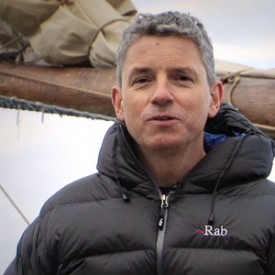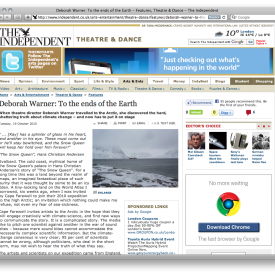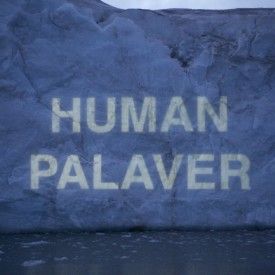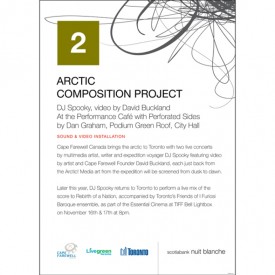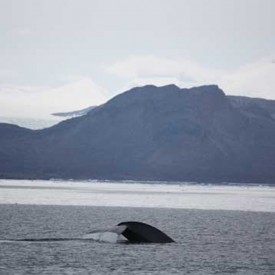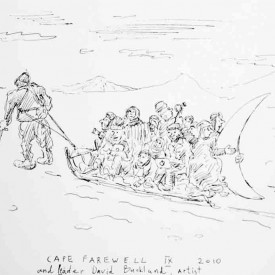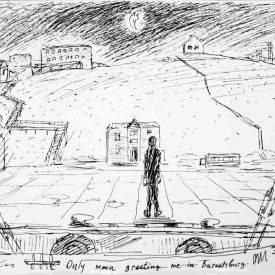Almost midnight; the Nooderlicht is moored in snow-blasted Fuglefjorden in north-west Svalbard, and we are all huddled together on the deck to watch the marvel of nature we’d been hoping we might witness; a polar bear diving in the freezing black waters; she’s tearing meat from the sunken carcass of a whale to feed herself and her cub, which waits on the rocks each time she vanishes underwater.
The polar bear is the ubiquitous symbol of the Arctic; the first one we encountered was stuffed and marooned on the plastic floe of the luggage belt in the Arrivals hall of Longyearbyen airport here in Svalbard; The next encounters were in the hotel lobby, more in the shops, and on fridge magnets and postcards.
We’ve sailed as far north as far as we can; we’re about 600 miles from the pole, near the top edge of the map. My first reaction to the astounding scenes, the epic sublime of this island’s natural landscapes, was to go “wow!” like an enthusiastic dog to almost everything I saw.
A few days on, let me admit I’ve had only the most banal of revelations, and it’s no more than this: everything truly is connected. Just as we have travelled north by way of plane and boat, so now I know, thanks to talks from the scientists on the boat, our muck and toxic manufactured crap are carried up here on the winds and by the Gulf Stream, a branch of which flows north, carrying warm waters and weather to Ireland, the UK and Scandinavia, and then up to the Arctic. Toxic pollutants from river waters and factory chimneys in Europe and Russia travel north on the same currents, and they gather and collect in this, one of the last great pristine environments in the world. POP (Persistent Organic Pollutants, eg: industrial chemicals like PCBs in plastic, and dioxins which are produced when we burn plastic, and pesticides) are legally banned by the Stockholm Convention, and yet up here they’re found accumulated in all their poisonous potency, in high volumes, infecting and conquering the food chain. They cause a range of hideous effects; cancer, neurological defects, reproductive and immune system damage. Mercury from the incineration of rubbish passes into the air, then falls in raindrops into the sea, and is absorbed by fish, which are then eaten by mammals.
Are you glazing over yet? Back to the polar bear: these nasty chemicals accumulate in the winter fat of seals, which are eaten by the bears, the kings of the chain, which then pass on the toxins to their cubs in their milk. There’s something called bioaccumulation, which means the quantity and potency of the toxin accumulate exponentially. Ie, the higher up the food chain, the worse the effects. So now, a significant number of the Svalbard polar bears are found to have mutations, for example carrying both female and male genitalia. So the astounding creature we watched from the deck of the ship is carrying within itself, and passing on to its cub, the time-lapse curse of our toxic waste.
Meanwhile, back on the ship: despite its popularity, and for all the cuddly imagery, a consensus around the dinner table here is that the polar bear can’t work as the face of Climate Change. We might feel sorry for them, but it’s all too far away to be real, and it almost certainly won’t change human behaviour. But what will? The more we talk, the more I listen in to the scientists talking, the more complex and infinitely sophisticated the issues seem.
The other consensus is that most of the effects of climate change are happening elsewhere, and only when petrol station forecourts and shopping malls in the Midlands and the Mid-West are really hit by the brutal reality of climate change will we change. And how bad would things have to get for that to happen?
But at least I’ve had my mini-eureka moment. Everything is connected with everything else; things we do without thinking much at home have consequences thousands of miles, away in the Arctic. It’s the simple truth. It could be multiplied in thousands of instances all around the world.
Much more than that, I’ve seen the polar bear, not stuffed, not on a badge, not on a fridge magnet, not in a zoo. I’ve seen one diving for food, and another one regarding us from the home ground of its ice floe. I know now they’ve been adversely affected by the pollution we’ve dumped in the oceans and the air.
Everything is connected. The bears beauty and grace and power and freedom, will stay with me always. I’ll remember too how they looked at us as we gathered on the deck of the boat; mildly curious, as if we were creatures behind bars, in a sad zoo of our own making.
Photo by Nina Horstmann.
BACK TO TOP